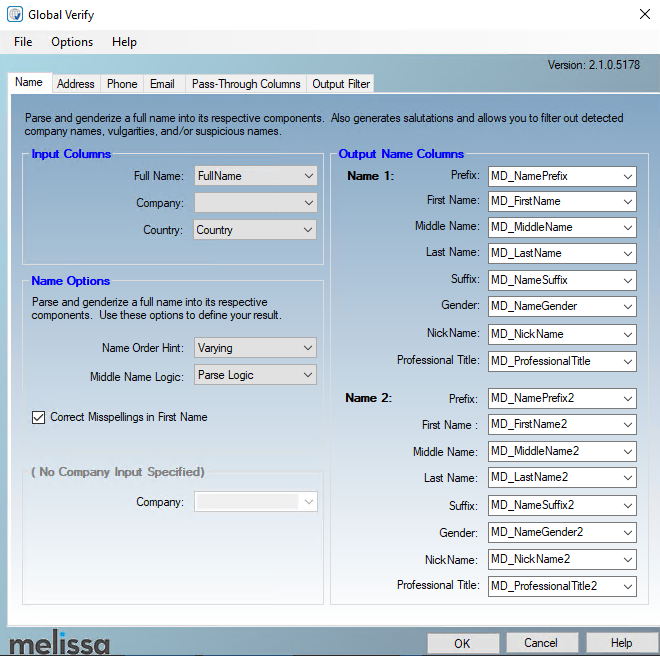SSIS:Global Verify:Name
← SSIS:Data Quality Components
| Global Verify Navigation | |||||||
|---|---|---|---|---|---|---|---|
| Overview | |||||||
| Tutorial | |||||||
| |||||||
| |||||||
|

Parse and genderize a full name into its respective components.
Input Columns
- Full Name
- Select the field name that will contain the name information to be parsed. This field can contain one or two full names, such as “Mr. John Q. Smith, Jr.” or “John Q. and Mary S. Smith.”
- Company
- If the database records may be business type, include the company name here.
- Country
- The Country name input will be used during processing as a reference point to use the selected Country's common language for more efficient Name parsing. The Country name, abbreviation or ISO code can be used.
Name Options
- Name Order Hint
- The Name Order Hint tells the Component in what order the name components will be found in the input full name, normal name order, last name first, or a mixture. The default is Varying. The options are:
Option Description Option Description DefinitelyFull Name will always be treated as normal name order, regardless of formatting or punctuation. VeryLikelyFull Name will be treated as normal name order unless inverse order is clearly indicated by formatting or punctuation. ProbablyFull If necessary, statistical logic will be employed to determine name order, with a bias toward normal name order. Varying If necessary, statistical logic will be employed to determine name order, with no bias toward either name order. ProbablyInverse If necessary, statistical logic will be employed to determine name order, with a bias toward inverse name order. VeryLikelyInverse Name will be treated as inverse name order unless normal order is clearly indicated by formatting or punctuation. DefinitelyInverse Name will always be treated as inverse name order, regardless of formatting or punctuation. MixedFirstName Name field is expected to only contain prefixes, first, and middle names. MixedLastName Name field is expected to only contain last names and suffixes.
- Middle Name Logic
- This option controls how the Component will parse the Middle Name, depending on the method selected. The default setting is Parse Logic.
Option Description Parse Logic In the absence of a hyphen, recognizable last names in the middle of a full name are treated as part of a hyphenated last name. Hyphenated Last The middle word is assumed to be part of the last name. Middle Name The middle word is assumed to be a middle name.
- Correct Misspellings in First Name
- If checked, the Component will use a database of common given names to correct obvious misspellings.
Company Output
- Company
- The company name.
Output Name Columns
- Name 1
- These fields apply to the first full name detected.
- Name 2
- These fields apply to the second full name detected.
- If the FullName input property contains multiple names, they'll be located under Name 2.
- Prefix
- This field returns any part of the name that precedes the given name, such as “Mr.,” “Ms.,” or “Dr.”
- First Name
- This field returns the given name.
- Middle Name
- This field returns the middle names or initials.
- Last Name
- This field returns the family name.
- Suffix
- This field returns any part of the name that follows the family name, such as degrees (“MD” or “PhD”) and generational indicators (“IV” or “Jr.”.)
- Gender
- This field returns a gender indicator.
- Nickname
- This is a string value of an identified nickname from an inputted full name.
- A nickname is defined as an internal string surrounded by one of the nickname identifying characters [double quote], [single quote] or [parenthesis]. The identified nickname will be returned unstandardized with the identifier intact.
- Professional Title
- This is a string value of the professional title from an inputted full name.
- Many countries within the European Union identify professional titles as a datatype preceding the first name but separate from a name prefix.